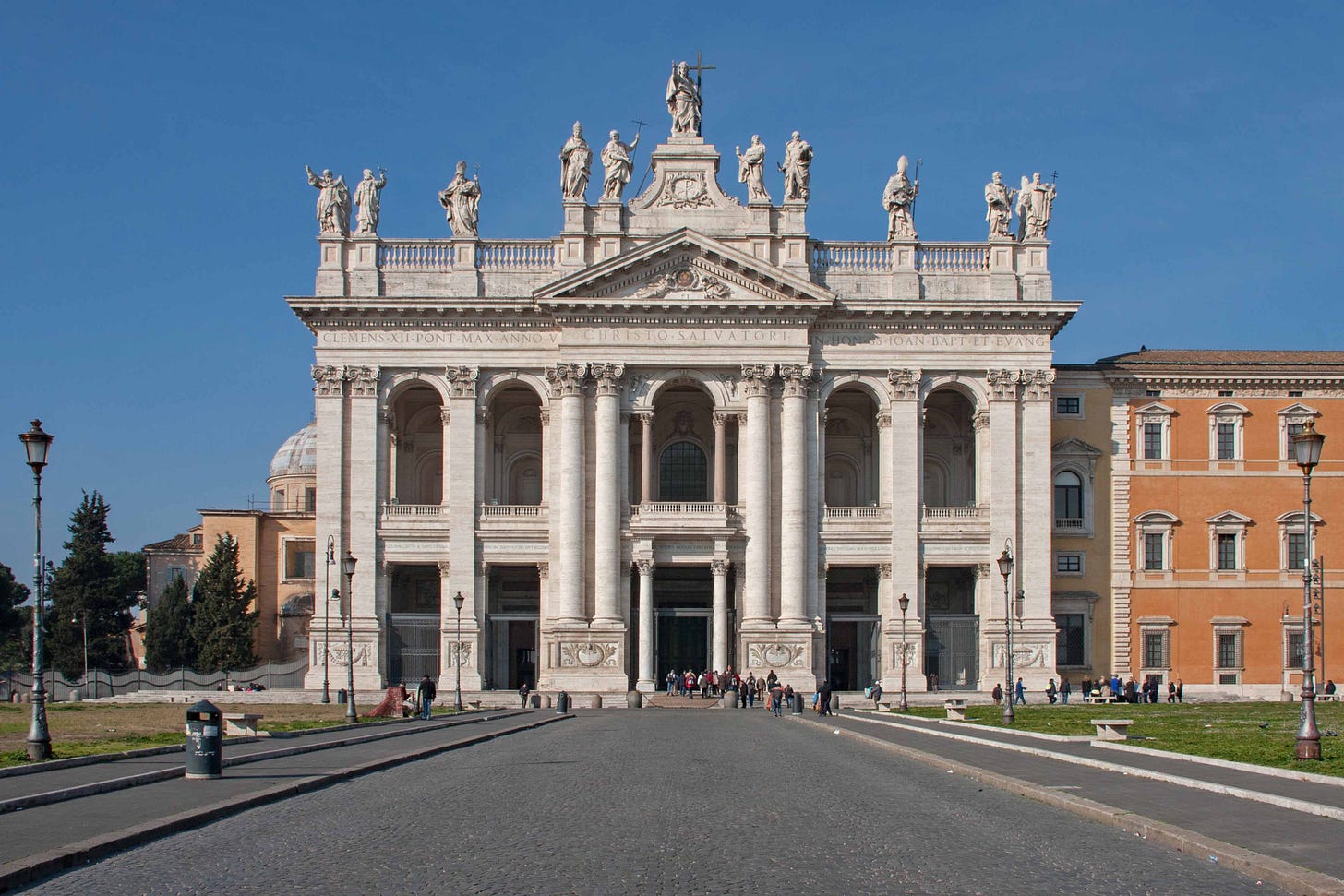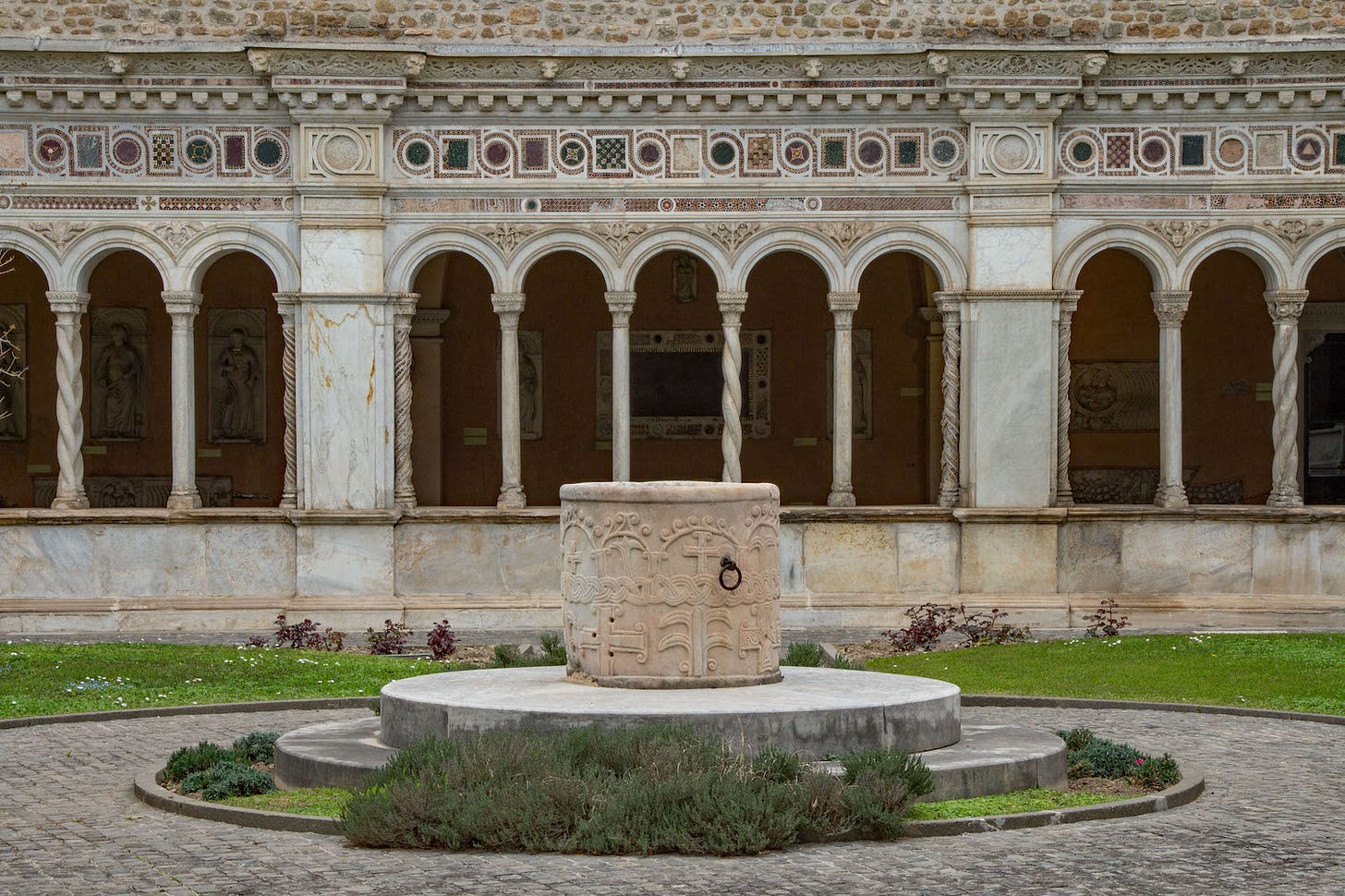The Throne Room of the Pope
The overlooked wonder of Rome that hides in plain sight...
Perhaps the most widespread, and entirely understandable, mistake of first time visitors to Rome is to assume that Saint Peter’s Basilica is the Pope’s official church.
The most senior church in Christendom, however, is to be found just a short walk away from the Colosseum. It is the Archbasilica of Saint John Lateran — or, as the inscription on its façade boldly declares, the “Head and Mother of all Churches in the City and the World”.
As the seat of the Petrine See, it is here that the throne of the Pope is located. For this reason, the last great ceremony to accompany the enthronement of a new Supreme Pontiff sees him formally take possession of this great basilica, as indeed the newly elected Pope Leo XIV did just last Sunday, the 25th May 2025.
Yet for many in the West, even for many Catholics, the historic Saint John Lateran is easily overlooked. But why?
Today, we explore how this all too often forgotten hill, half a mile behind the Colosseum, emerged as the heart of Western Christianity — and how too it fell from the limelight…
But first — one more spot remaining on our retreat to Rome this summer!
An extra spot has just become available on our Roman retreat this June 23-27. During it, we’ll visit the Roman Forum, Villa Farnesina, Saint John Lateran, and many other overlooked historic sites — all while studying the lives of the men who made Rome great.
Click here to learn more and reply to this email if you’d like to join us!
The Donation of Constantine
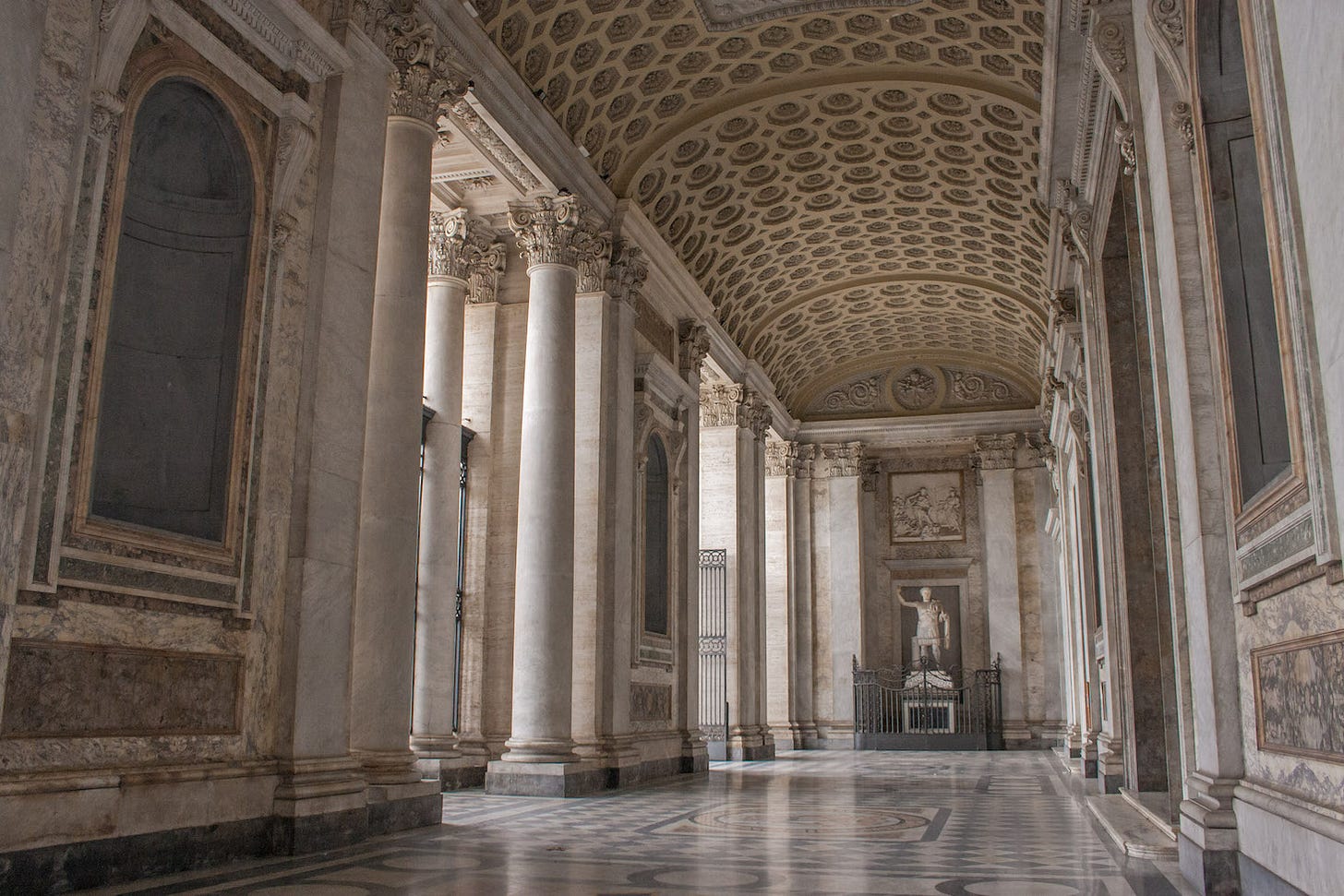
A little to the east of the rustic heights of the Caelian Hill, on the fringes of the ancient city of Rome, rises the modest spur of the Lateran Hill. It is named “Lateran” after the Laterani, a noble family who once possessed a stately residence here.
In AD 65, the family would fall afoul of the Caesars when one of their number, the Consul Plautius Lateranus, was implicated in a major plot on the life of the Emperor Nero — the Conspiracy of Piso. Thus the mansion of the Laterani was confiscated, and merged into the imperial estate.
Over a century later, part of this plot of land, on the southeastern extremity of Rome, was redeveloped by the Emperor Septimius Severus for military purposes, primarily to house the barracks of the imperial cavalry. Yet it was under another Caesar that the Lateran would find its true calling.
Following his vision at the Milvian Bridge, in AD 313 Constantine the Great promulgated the Edict of Milan, ending the persecution of the Christians and restoring the property that had been wrongfully seized from them. It was in the wake of this momentous event that the first Christian Emperor of Rome granted to Pope Miltiades the Lateran site, permitting the Christians to emerge from the catacombs and profess their faith above ground at last.
Thus the old palace of the Laterani was transformed into the Patriarchium, the first Papal residence, and in AD 324 — the same year the city of Constantinople was founded — Pope Sylvester there consecrated the first basilica of Western Christianity, proclaiming it Domus Dei, or ‘House of God’, dedicated to Christ the Saviour.
Before long, the Roman Empire was waning, but Christian Rome was dawning…
The Throne of the Roman See
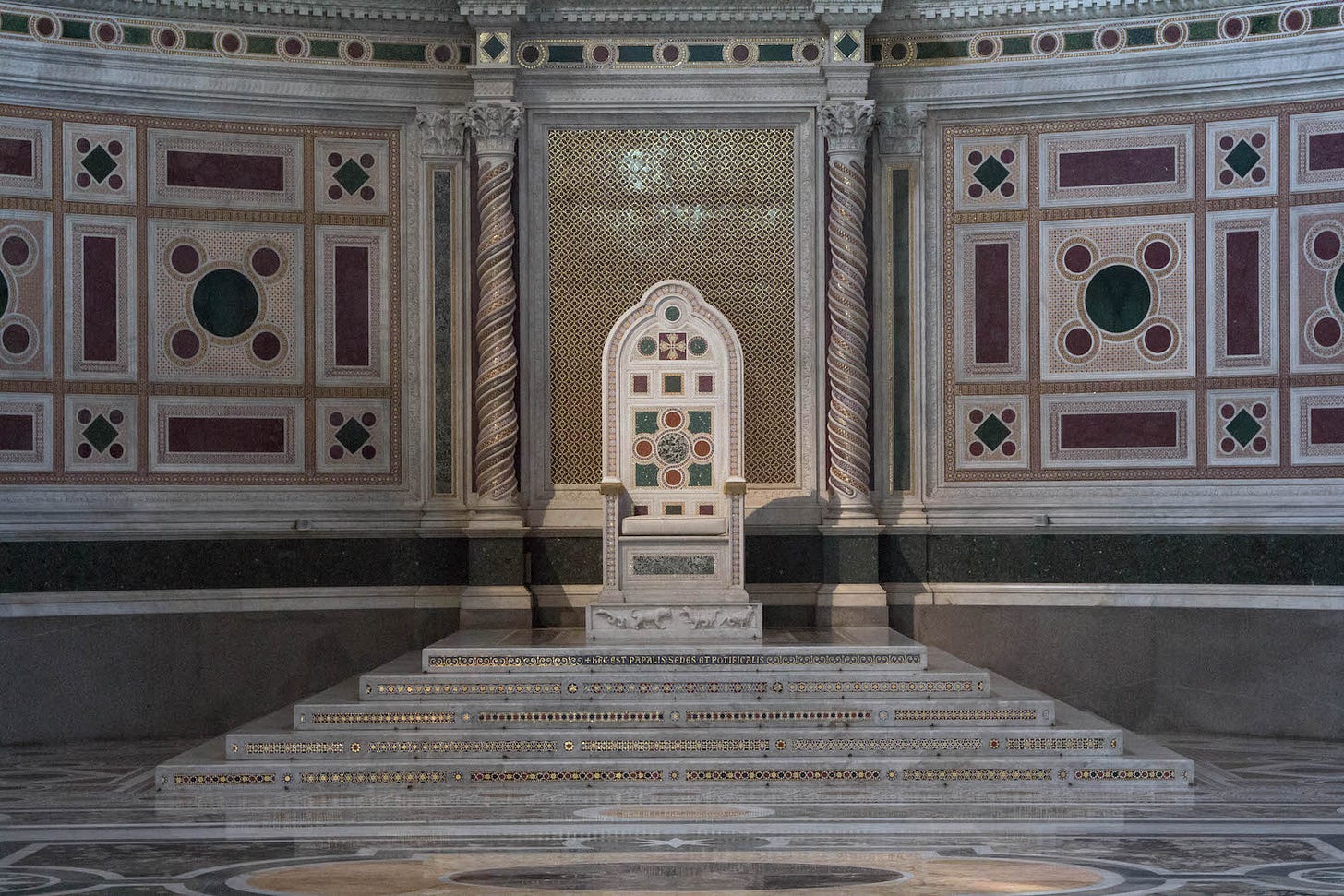
The Pope, as the successor to Saint Peter, is by virtue of his office the Bishop of Rome. Since the Lateran ‘House of God’ was the first basilica, it was here that the cathedra, or bishop’s throne, was placed, and it is this which establishes the basilica as the Cathedral of Rome.
The Papal throne has resided here ever since, though the centuries have taken their toll on its physical substance. The cathedra we see today (pictured above) is indeed of more modern manufacture, yet the predella, or base it rests upon, is the surviving remnant of a 13th century predecessor. Carved upon it are the images of an asp, a lion, a dragon and a basilisk — the monstrous creatures it is written that the victorious Christ shall triumph over:
“Thou shalt tread upon the asp and the viper: the young lion and the dragon shalt thou trample under feet”
Psalm 91:13
It is indeed an extraordinary testament to the Lateran Basilica just how much it has endured and survived. When the power of Rome crumbled in the West, in AD 455 its remarkable treasures were pillaged by the hordes of the Vandal warlord Gaiseric. Four centuries later, in an event widely seen as a divine damnation of the despicable deeds of Pope Stephen VI, a terrible earthquake brought down the vault.
It was in the wake of this disaster that in AD 905, Pope Sergius III dedicated the reconstructed basilica to Saint John the Baptist, several relics of whom are housed within, before Lucius II later expanded the dedication to Saint John the Evangelist too.
Thus the first church of the West began to assume its present name, as the Basilica of Saint John Lateran…
Fire and Zeal
All through the centuries of the height of its medieval prestige and influence in Europe, the Papacy resided at the Lateran. As a result, many foundational moments in Christendom occurred upon this modest hill.
The First, Second, Third and Fourth Lateran Councils, each convened in the Lateran Palace over the course of the 12th and 13th centuries, affirmed by law, among other things, the expectation of priestly celibacy and the standards of clerical dress, while condemning the evils of simony (ecclesiastic corruption). The most visible testament to this ‘Lateran golden age’ is the spectacular cloister that Pope Honorius III commenced work on in 1222, which is one of the finest surviving examples of medieval craftsmanship in Rome, and is indeed one of the few elements of the Archbasilica which survived the disasters to come.
The high watermark of that golden age was undoubtedly the year 1300, when Pope Boniface VIII proclaimed and presided over the first Jubilee in the history of the Western Church. Hundreds of thousands of pilgrims flocked to Rome, and for each of them, a visit to the oldest church in the Eternal City was an essential stop on the itinerary.
The jubilation, alas, would be short lived. In 1308, the Archbasilica was ravaged by fire. Far worse, however, followed almost immediately. Months later, in the culmination of an exceedingly acrimonious fallout between the French Crown and the Papacy, the newly elected Pope Clement V, himself a Frenchman, promptly abandoned Rome and transferred the Papal Court and Curia to Avignon in France.
It was a decision that proved catastrophic for Rome and for Western Christianity, and the deplorable state of the Lateran was an aching symbol of it.
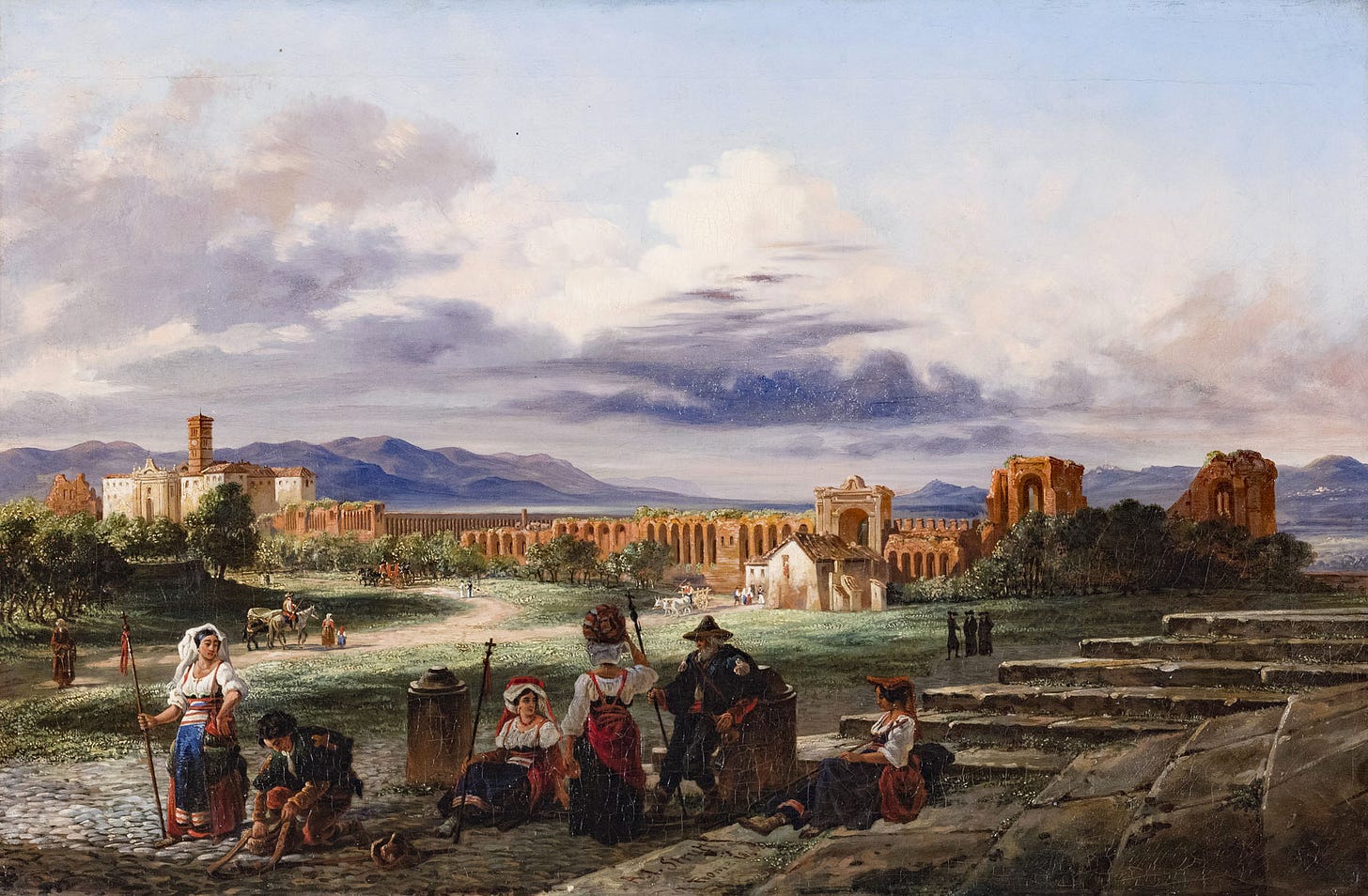
Gutted by the blaze, the wounded complex would be devastated by a second conflagration in 1361. Both fires bookended one of the worst periods in the city’s history, which had seen a considerable proportion of the populace succumb to the Black Death, and the streets of Rome surrendered, in the absence of the Papal government, to crime.
It would take the heroic intervention and imploring words of Saint Catherine of Siena to persuade Pope Gregory XI to finally return to Rome in 1377. But the chaos of Italy, the wretched state of the city, and the Pope’s sudden death just months later triggered a major schism in the Church that prolonged the disaster by a further forty years.
The Popes would seek temporary accommodation at the Basilicas of Santa Maria in Trastevere and Santa Maria Maggiore. But by the time the Western Schism was at last healed, and Pope Martin V fully restored the Papacy to Rome in 1420, the will and means to restore the Lateran complex, by then a decrepit ruin that had been rotting for decades, had vanished.
While the Archbasilica itself, as the Cathedral of Rome, was spared the indignity of further decay, the Lateran would never again host the residence of her bishop, as the successors of Saint Peter turned to the more sanitary and defensible hill of the Vatican on the opposite side of the city.
For the Lateran, the future looked bleak — but then came the Renaissance…
Keep reading with a 7-day free trial
Subscribe to INVICTUS to keep reading this post and get 7 days of free access to the full post archives.



